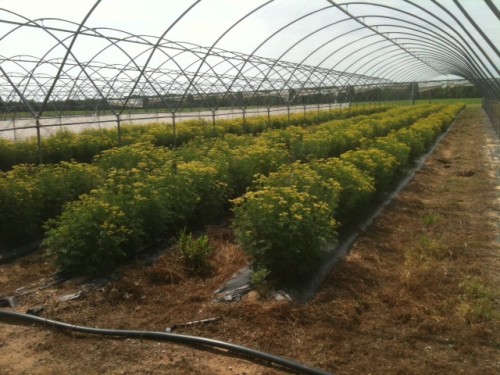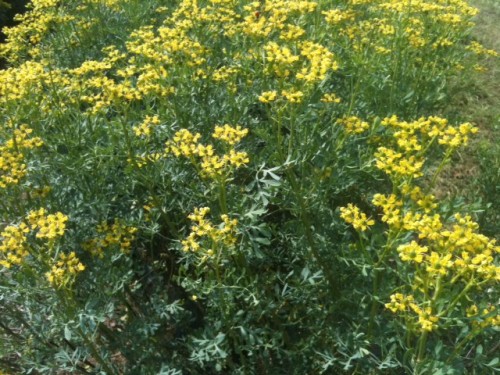by Briscoe White | Jul 21, 2011 | Miscellaneous |

After seeing the pictures of me holding a hummingbird, some of you may be wondering “Wow, does he have lightening-quick, superhuman speed?!” Although I can can be quick on my toes, the story behind these pictures is not quite THAT phenomenal. (But it’s still a neat tale!)
It all started with our orchard. As a side project, I’ve been tinkering with growing peaches, apples, pears and cherries. It was early spring and I was preparing to spray the orchard with an organic-based insecticide to keep the bugs from enjoying the literal fruits of my labor. I’d parked my tractor outside of our office and ran in to check on things, leaving the door to my tractor cab open. When I returned, this little hummer was flitting around frantically inside, trying to find his way out. (I thought they were attracted to RED objects. My tractor is green. Maybe this guy was colorblind?) I gently followed him with my hand until he tuckered out long enough to land for a few brief seconds and just reached out and slowly grabbed him. When I touched him, it was as if he had gone into a faint, as he just went limp and let me pick him up. I guess he knew what was good for him! After taking a few quick photos, I let him go and he flew up into one of our trees out front. We’ve been keeping a close eye on our feeders and wondering which one might be him!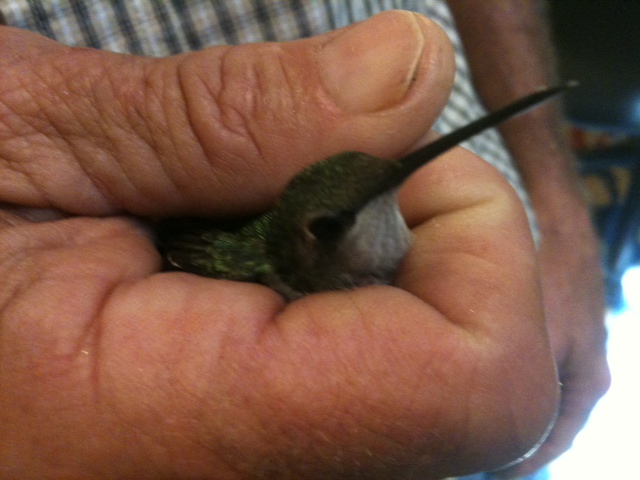
To attract some fast friends to your garden or yard, try placing multiple hanging and staked feeders in different areas, out of sight of each other. This will limit competition, as hummingbirds can be very territorial. Try mixing it up and placing some in trees in the shade, some staked in your garden near non-red flowers, and some right outside of your window to see which one they like the best!
Briscoe’s Hummingbird Fuel
For a great nectar mix to fill your feeders with, give this a try. Just remember to change the sugary mix weekly though, as it can go bad in the summer heat.
- 1 Cup White Sugar
- 4 Cups Water
Just bring the water to a boil and dissolve the sugar, stirring frequently. Let it cool, and add it to your feeders. Adding red dye isn’t necessary if you have a good, brightly colored red feeder. The dye just adds foreign chemicals to the bird’s diet which can’t be good.
by Briscoe White | Jul 21, 2011 | Miscellaneous |
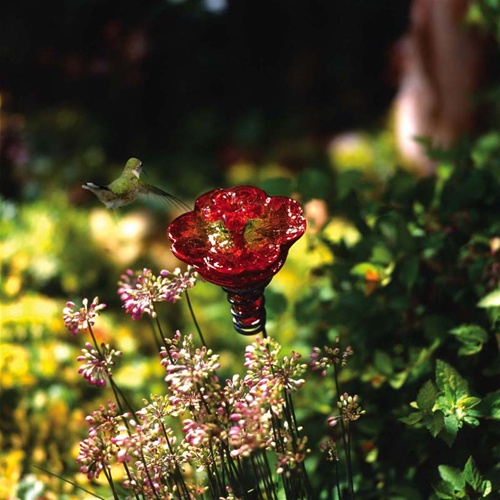
There are three varieties of Hummingbirds that frequent our area in Virginia, the Rufous, Allen’s and the Ruby Throated hummingbird. Our favorite is the last but not least in that list, for its brilliant hues and and signature ruby-red colored throat.
Highly curious and very attracted to feeders, the Ruby Throat is one of the most common and recognizable hummingbirds in the eastern half of North America. Living up to their name, males have vibrant green feathers, white stomachs and a red “ruby” throat, while females are larger and resemble males in coloring, but lack that namesake red throat. Hummingbirds often become so adapted to people that they may even dive closer to explore your red wardrobe, and seem indifferent to being watched closely while feeding near windows or patios. Hanging a hummingbird feeder near a large window is one of the most relaxing ways to pass time, as many males become territorial over their feeder and spend a lot of time chasing others away. (If hanging a feeder is difficult, we also have a great Staked Hummingbird Feeder that includes a stake for easy placement.) These fast, feathered air battles are more dramatic than your favorite soap opera and more entertaining than most sporting events! It’s best to place multiple hummingbird feeders throughout your yard, out of sight of each other, so that territorial lines aren’t crossed as often and everyone gets a chance to feed. Placing your feeders in the shade will also help give these hardworking hummers a respite from the hot summer sun!
Most of these hummers migrate to the deep south and Caribbean to wait out the cold winters, but tend to show back up with the blooming of spring flowers in late April and early June, here on the east coast. Beautiful and entertaining, these quick, little birds are terrific pollinators in your garden and drink half to eight times their body weight in nectar, and frequently dine on small, soft insects. During the sweltering summer months, make sure to change the sugary “nectar” in each of your feeders once a week, regardless of whether the birds have been feeding or not. This keeps the sugar-water fresh, as it will actually spoil in the summer heat. Though they love red, tubular shaped flowers, they will visit other sweetly-scented blossoms and blooming aromatic herbs as well. Try planting Asclepias ‘Tuberosa’, Bergamot and Lobelia to create a hummingbird habitat in your garden. Doing so will increase the health of your garden and give you a great, natural hive of activity to study!
by Briscoe White | Jul 13, 2011 | Miscellaneous |
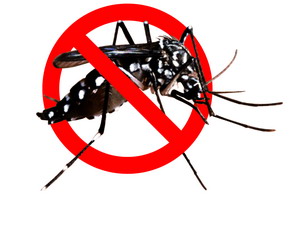
Summertime in Virginia not only means hot, humid temperatures; it sounds the call to break out the bug spray if you plan to be outside for more than five seconds.Yet, with so many chemicals and air pollutants found in commercial, over the counter brands, why not grow your own insect repellent and protect yourself the natural way? If your troubles with pests have grown substantially then it might be wise to compare Terminix vs other pest companies before deciding on the services of the right professional for the job. The majority of retail sprays, candles, coils and other creative contraptions to keep you safe from the summer swarms contain harmful toxins, including DEET, which can lead to serious health issues, especially for expecting mothers, children or pets. By planting herbs that are rich in natural sources of citronella and other repellent oils, you can skip the potential side effects and safely protect your family from pests all summer long. Alternatively, depending on where you live you could also look to hire similar services to this Roanoke pest control company that can help you exterminate any unwanted pests in your household and garden.
Lemon Grass (Cymbopogon citratus):
This light, lemon-flavored culinary herb commonly found in Asian and Indian cuisine is at the top of our list for its versatile usage and potent repellent properties. Though annual in most areas, this heat-loving, tropical herb is closely related to the variety of grass (Cymbopogon nardus) that citronella oil is derived from, which is found in most commercial repellents. Although it may not be as potent as its cousin, the citratus variety still contains enough essential oils to ward off backyard buggers. You can either plant this fragrant herb around your pools, water gardens and patios to enjoy skeeter-free evenings this summer, rub freshly cut stalks directly onto your skin, or steep them in hot water to release the volatile oils and once cooled, used that as a spray. In addition to its repellent properties, Lemon Grass is also anti fungal, antibacterial, helps detoxify your liver, reduces cellulite and more! Lemon Grass grows quickly, so you can harvest it as often as you like. What you don’t use to keep pests away, you can add to your favorite stir fry or brew into a refreshingly healthy tea.
Peppermint (Mentha piperita):
Not just a common scent around the holidays, Peppermint can also help defend your skin from mosquito attacks, while offering a few other beneficial results. Of all of the various types of Mint, Peppermint has one of the highest concentrations of volatile oils, hence its strong minty flavor and aroma. Peppermint has long been loved as a medicinal herb for its many uses in treating digestive issues, and has also been proven to enhance your memory! This hardy, low-growing and quick-spreading herb is well known to many as a flavoring or culinary herb used in jellies, desserts, gum and other recipes, but many underestimate its ability to thwart pests. Containing high levels of menthol, Peppermint keeps mosquitoes, lice, ants, fleas and even rats at bay with its minty scent. Those with pets will know that summer is peak flea season and, in addition to flea collars from places like DewelPro, pet owners find themselves looking for ways to make life easier for their four-legged friends, so knowing peppermint could detract them is very useful. As most insects dislike pungent herbs, a good rule of thumb when considering what to plant is, the stronger it smells, the more likely it is to help keep pests away. This vigorous herb is a proven winner. You can surround your home with a minty barrier and enjoy the lovely, crisp perfume each time you brush past these plants. For more controlled growth, you can easily container plant Peppermint and keep it indoors, allowing its natural perfume to freshen your home.
Catnip (Nepeta cataria):
Cat lovers and most pet owners should be very familiar with this herb that felines flip for. When kitties roll in or ingest this easy to grow herb, it induces euphoric behavior ranging from tearing around the house madly, to lounging around and drooling. A cousin to Mint, Catnip is a very low maintenance herb that will grow vigorously. The active oil in Catnip is Nepalactone, the very same volatile oil that drives your cat wild, while protecting you from becoming a snack for mosquitoes. Nepalactone has been researched and proven to be more effective in repelling mosquitoes in lower concentrations than the commercial chemical DEET, which is a key ingredient in most retail repellent products. It also seems to have an effect on cockroaches, and can be steeped in hot water and made into a “tea” for spraying baseboards where they may be hiding. Make sure to dilute the Catnip oil in water, or to rub it on your clothing rather than your skin, as the oil can affect people who have dermal sensitivities and may cause irritation if applied in a concentrated amount.
by Briscoe White | Jun 30, 2011 | Miscellaneous |
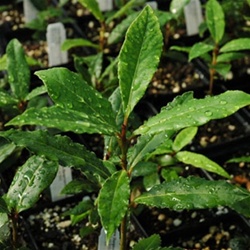
In a business that revolves around things growing, and some plants grow verrrrrrrry slooooooooowly, patience is a virtue. (Any gardener who loves Bay Trees can attest to this! They take FOREVER to grow, but it’s well worth the wait) Our patience is often rewarded by new growth, beautiful blooms, delicious vegetables or the literal, juicy fruits of our labors. The same patience is needed in planning, and acclimating new plants. When you receive new plants, especially if by mail, the patient gardener will always be the most successful. Upon excitedly opening your new box of plants, make sure you take the time to thoroughly read our planting instructions and then acclimate your plants for a day or so, in a shaded spot. They may be jet lagged from transit, as any of us would be, and may need a drink of water and a moment of relaxing rest in the shade before being asked to perform in your garden. Please make sure to read and heed these directions as well as our section found on each plant product page called “Briscoe’s Tips” for specific planting instructions, because more often than naught, planting immediately doesn’t allow the plant to recuperate from traveling in a box for a few days. So just remember friends:
When you get your new plants, don’t be antsy in the pants;
your herbs will do best, if given water and rest!
by Briscoe White | Jun 8, 2011 | Miscellaneous |
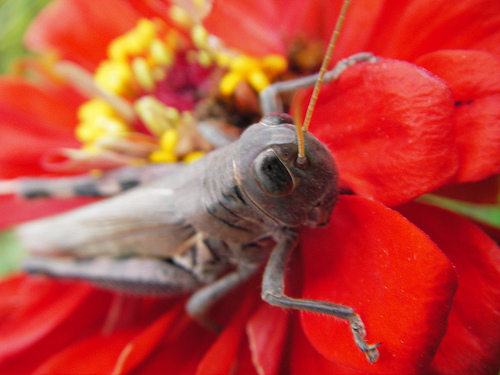
Having trouble with grasshoppers munching your plants? Don’t grieve for grasshoppers this summer, protect your garden naturally!
Try this Garlic Oil Spray:
1) Soak 3 ounce of garlic and 1 ounce of mineral oil for 24 hours or more.
2) Separately, mix 1 tsp. fish emulsion with 16 ounces of water and 1 tbs. castile soap.
3) Slowly mix the two mixtures together. This should keep in a sealed jar for up to 2 months.
4) To Use: Mix 2 Tbs. Garlic “concoction” per 1 pint of water and spray!
You can also plant herbs like Cilantro, Pyrethrum, Rue, Calendula or Horehound to act as natural deterrents to your unwanted grasshopper guests. These herbs also keep other critters and creepers out of your garden and some can even be used for culinary purposes.
by Briscoe White | May 23, 2011 | Miscellaneous |

Well it’s been well over a month since we planted our employee garden and the fruits (and veggies) of our labor are beginning to show! We’ve already been reaping tons of greens from our cold frame garden, and now our squash, zucchini, and green beans are starting to yield enough for dinner. With the week of heavy rains that we’ve had here in Charles City, VA, it’s no wonder that our plants are starting to really get big. We harvested a flat of baby squash and zucchini on Friday and the girls in the office all enjoyed them over the weekend. Our Marketing Director Caroline, tossed them in with fresh kale, onions and garlic for a delicious dinner packed full of fresh vitamins!
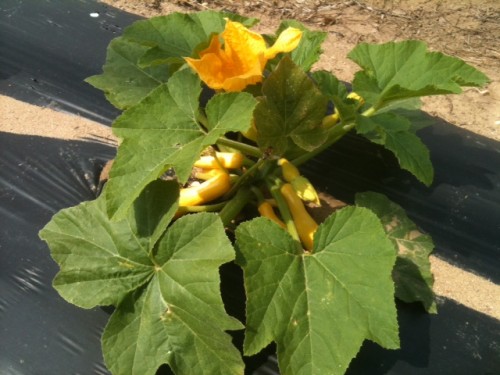
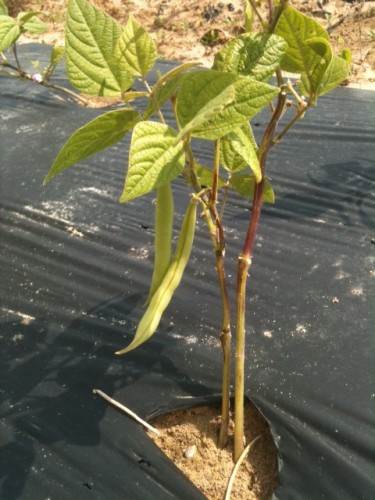
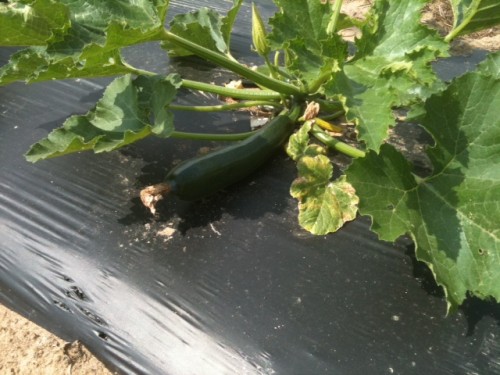
In attempts to keep our garden free of pests, we’ve planted our tunnel veggies near our Rue field. Rue is a natural insect repellent, and as a result, we’ve had considerably less critters trying to feast on our vegetables. Rue is also a great rabbit, deer and domestic pet deterrent, so if you’re having problems with pests, trying planting a perimeter of this hardy perennial around your gardens.
